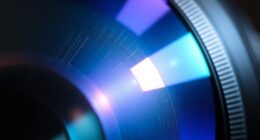Spectral sensors help you monitor air pollution accurately and in real time by detecting specific airborne contaminants through light spectrum analysis. They provide detailed data on pollutants, enabling quick identification of pollution sources and trends. Proper calibration and data visualization guarantee reliable results and easy understanding. Integrating these sensors into your environmental efforts supports faster responses and better decision-making. Keep exploring to discover how this technology can transform your air quality management.
Key Takeaways
- Spectral sensors provide real-time, precise identification of airborne pollutants through light spectrum analysis.
- Proper calibration ensures measurement accuracy and reduces errors caused by environmental factors.
- Data visualization converts spectral data into clear visuals, aiding quick pollution assessment and trend detection.
- Calibration tools with automated routines and environmental adjustments maintain sensor accuracy over time.
- Integrating spectral sensors with data platforms enables continuous monitoring, hotspot identification, and timely alerts.

Spectral sensors are revolutionizing how we monitor air pollution by providing precise, real-time data on airborne contaminants. These advanced devices detect specific pollutants by analyzing the light spectrum they emit or absorb, enabling you to identify harmful particles with remarkable accuracy. However, to guarantee the reliability of this data, proper sensor calibration is essential. When you calibrate your spectral sensors correctly, you align their measurements with known standards, reducing errors caused by environmental factors or sensor drift. Regular calibration helps maintain high accuracy over time, so you can confidently interpret the data and make informed decisions about air quality.
Proper calibration of spectral sensors ensures accurate, reliable real-time air pollution data you can trust.
Once your sensors are calibrated, the next step involves effective data visualization. Converting raw spectral data into clear, understandable visuals allows you to quickly grasp pollution levels and identify patterns or sources of contamination. Whether you’re monitoring urban air quality or industrial emissions, visual tools like graphs, heat maps, or real-time dashboards help you see trends at a glance. This visual clarity enables prompt responses to pollution spikes and supports communication with stakeholders or the public. Good data visualization turns complex spectral readings into actionable insights, making your monitoring efforts more impactful.
Spectral sensors also come equipped with sophisticated software that simplifies the calibration process. These tools often include automated routines that compare sensor outputs against reference standards, streamlining calibration and reducing manual errors. As you perform calibration, pay attention to environmental conditions such as temperature and humidity, which can influence sensor accuracy. Incorporating these factors into your calibration routine guarantees your data remains precise regardless of external variables. After calibration, continuous monitoring of sensor performance is crucial; periodic recalibration prevents drift and keeps your data trustworthy.
In addition, integrating spectral sensors with data visualization platforms enhances your ability to analyze large datasets efficiently. By linking sensors to dashboards that display real-time information, you can monitor air quality around the clock and identify pollution hotspots. These platforms often offer customizable alerts, so you receive immediate notifications if pollutant levels exceed safe thresholds. This proactive approach helps you respond swiftly to air quality issues, minimizing health risks and environmental impact.
Furthermore, understanding sensor drift and environmental influences is vital to maintaining the accuracy of spectral sensors over time. By recognizing how external factors like temperature and humidity impact measurements, you can implement more effective calibration routines and ensure data consistency. Ultimately, the combination of meticulous sensor calibration and dynamic data visualization empowers you to monitor air pollution more effectively. You gain a detailed understanding of airborne contaminants, their sources, and their fluctuations over time. This knowledge not only supports regulatory compliance but also guides policy decisions and community health initiatives. With spectral sensors, you’re equipped to take a more precise, proactive stance on air quality management, ensuring cleaner, healthier environments for everyone.
Frequently Asked Questions
How Do Spectral Sensors Compare to Traditional Air Quality Monitors?
Spectral sensors often outperform traditional air quality monitors in spectral accuracy, providing detailed data on specific pollutants. You’ll find they’re more versatile and faster, especially when properly calibrated sensors are used. Unlike traditional monitors, spectral sensors can detect a wider range of pollutants in real-time, allowing you to react quickly. Regular sensor calibration guarantees consistent accuracy, making these sensors a reliable, advanced choice for air pollution monitoring.
What Are the Limitations of Spectral Sensors in Urban Environments?
You might find spectral sensors limited in urban environments due to urban signal interference, which can distort readings and reduce accuracy. Additionally, these sensors often have a limited pollutant range, making it harder to detect diverse pollutants present in complex city air. This means you need to take into account potential interference and the sensor’s detection capabilities when deploying them for urban air quality monitoring.
Can Spectral Sensors Detect All Types of Air Pollutants?
Spectral sensors can’t detect all pollutants because their effectiveness depends on spectral resolution and pollutant specificity. You need high spectral resolution to distinguish between different gases accurately. While they’re great for certain pollutants like NO₂ or SO₂, some pollutants with overlapping spectral features or low concentrations may evade detection. So, you should combine spectral sensors with other methods to get a thorough view of air quality.
How Cost-Effective Are Spectral Sensors for Large-Scale Monitoring?
Spectral sensors are generally cost-effective for large-scale air pollution monitoring, especially when considering their potential for continuous, real-time data collection. You’ll find that their economic feasibility improves over time as installation costs decrease and maintenance remains low. Their ability to cover wide areas with fewer units makes them a smart investment, providing valuable insights while keeping expenses manageable in the long run.
What Maintenance Is Required for Spectral Air Pollution Sensors?
You need to regularly calibrate your spectral sensors to guarantee accurate readings, typically every few months or as recommended by the manufacturer. Additionally, check and replace filters periodically to prevent dust and debris from affecting sensor performance. Keep the sensors clean and protected from harsh environmental conditions. Proper maintenance, including calibration and filter replacement, helps maintain reliable data and prolongs the lifespan of your sensors.
Conclusion
Imagine spectral sensors as your vigilant lighthouse in the fog of air pollution. They shine a precise beam, revealing hidden pollutants with clarity you can’t see otherwise. By harnessing their power, you can monitor air quality in real-time, guiding actions to clear the skies. These sensors are your beacon for cleaner air, helping you navigate towards healthier environments. Embrace this technology, and let it illuminate the path to a gasp of fresh, clean air.









